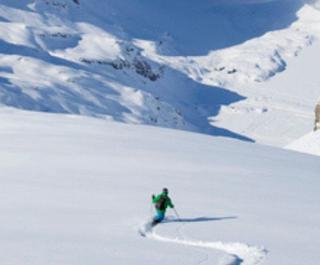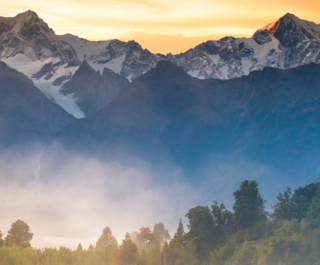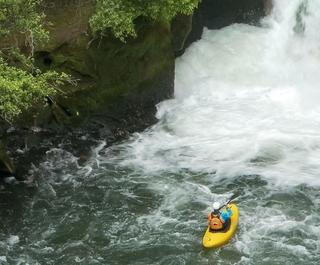
Before it comes into view, you hear it rumble. Water droplets trickle off leaves and pitter-patter onto the path. For a moment you think it must be raining, then you realise this is spray from one almighty waterfall. The path changes to a steel catwalk and the rumble grows loud as a train. Then Iguazú Falls is before you, a wild plunge of powerful water lost in its own spray below, and one of South America’s most stunning sights.
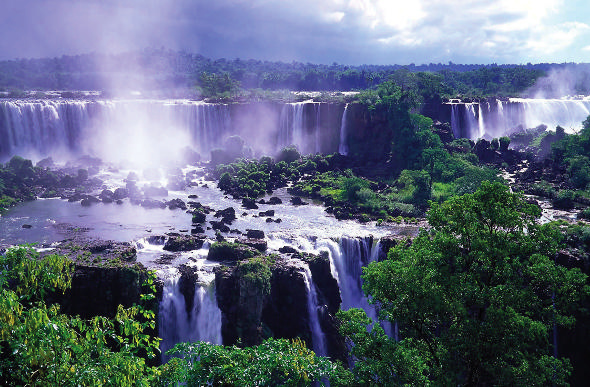 Aerial view of Iguazu Falls © LAN Airlines
Aerial view of Iguazu Falls © LAN Airlines
For all the photos and descriptions, few visitors are prepared for their first encounter with Iguazú (or Iguaçu in Portuguese), a mighty waterfall at the intersection of borders between Argentina, Brazil and Paraguay. It makes Niagara seem small: Iguazú is higher, strung out over several kilometres, and made up of 300-odd individual falls where two rivers plunge off a fissure in a basalt plateau. The exact number of cataracts fluctuates; go in the November-to-March rainy season if you can, when the falls are especially spectacular.
Iguazú Falls are remote, making airplane the practical way to get there. Most visitors fly into Puerto Iguazú on the Argentine side of the falls, a 90-minute flight from Buenos Aires. It’s possible to visit on a day trip, but stay a couple of nights if you can. If you have limited time and budget, base yourself on the well-organised Argentine side, which provides the best experience of the waterfalls, and where you’ll find a range of accommodation, good museum and a helpful tourist office.
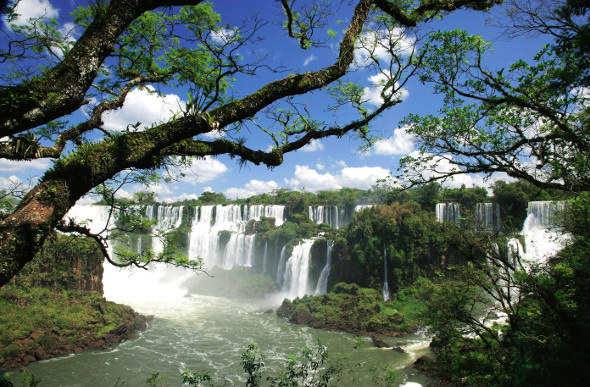 The jungle setting of Iguazu Falls in Argentina © Tourism Argentina
The jungle setting of Iguazu Falls in Argentina © Tourism Argentina
A little train runs from the park entrance to the falls, but you can easily walk the three kilometres to the Devil’s Throat and be rewarded with butterflies and jungle views along the way. Take a full day to visit the Devil’s Throat, the most visited and thunderous part of the chain of falls. Walk the Upper Circuit and Lower Circuit paths for up-close views, and then take one of the boats onto the river below the falls for a heart-banging encounter with the foaming water. You used to be able to take a boat above the falls too, just gut-wrenching metres from the sliding waters of the precipice, but this dicing with danger has now been banned.
On the Brazilian side, Foz do Iguaçu is a much bigger town than Puerto Iguazú and also has an airport. Accommodation is generally cheaper and the town’s ambience more energetic, with many hotels and restaurants offering samba shows and folk music. However, a half-day might be enough to see the falls here, though you might also want to budget time for the very good Parque das Aves, a bird park with walk-through aviaries housing luridly coloured South American birds. You may also be interested in a tour of the gargantuan Itapú Dam, one of the world’s largest hydroelectric power plants.
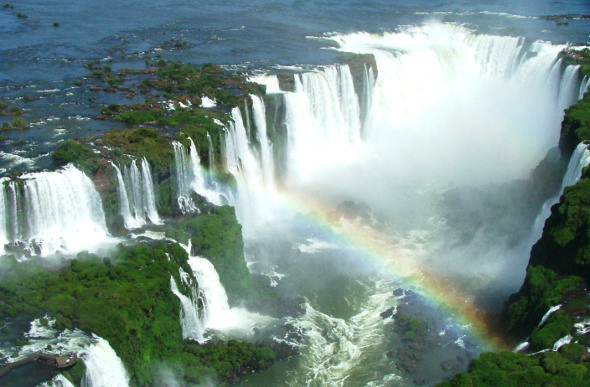 Aerial view of Iguazu Falls with rainbow © Tourism Argentina
Aerial view of Iguazu Falls with rainbow © Tourism Argentina
On the downside, you don’t get as close to the falls, and the Brazilian paths don’t have the same adventurous, Indiana Jones feel as those on the Argentine side. However, there are wider, more panoramic views of the waterfalls. Shuttle buses take you into the national park to the Hotel das Cataratas, where paths start. Walk through the forest to the bottom of Salto Floriano falls, then take the lift to the top for a great outlook. If you can afford it, a helicopter ride provides a breathtaking 10 minutes of bedazzlement.
There’s no reason why you have to choose between sides. The border crossing between Brazil and Argentina is fast and simple and can be made by taxi or public bus, or you can join a local tour – though you’ll need to have a visa for Brazil. It’s easier to get this before leaving home, but the consulate in Puerto Iguazú will normally issue one within 24 hours. Most ignore the Paraguay falls, since the bridge crossing is a half-day ordeal and Ciudad del Este has scant tourist amenities.
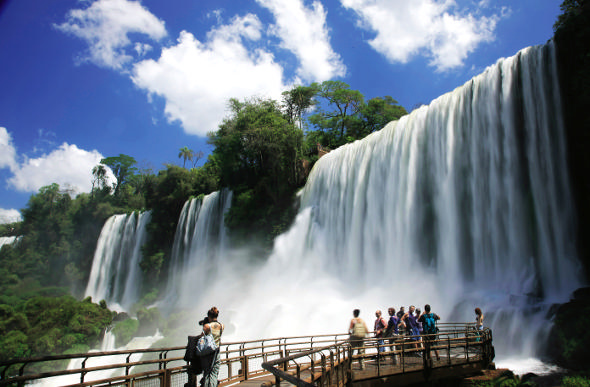 Viewing platforms at the foot of the Devil’s Throat, part of the Argentine falls © Tourism Argentina
Viewing platforms at the foot of the Devil’s Throat, part of the Argentine falls © Tourism Argentina
While the waterfalls are the prime attraction, the surrounds on both sides of the border are a vast national park and World Heritage site covering thousands of square metres. The vegetation is subtropical and given a helping hand by constant moisture from the falls’ spray. (For the same reason, you’d be wise to bring a plastic poncho and protection for your camera.) In theory you can spot more than 80 mammal species. Don’t feed the monkeys! warn signs as the monkeys themselves show off their gymnastics in the trees overhead.
Bird lovers can track down over 400-odd species, though tourist crowds have driven wildlife further away from the falls. You don’t have to be a bird-spotter to fall in love with bright-beaked toucans. Everywhere clouds of dazzling butterflies jiggle: yellow and purple, sky-blue and scarlet. And in the background the spray dances and shimmers and the waterfall rumbles in a truly splendid symphony.


